
This picture stood out to me because the people represent immigrants/asylum seekers/refugees and the billboard represents how easy it is for Americans to get in and out of our country and have security.

This picture stood out to me because the people represent immigrants/asylum seekers/refugees and the billboard represents how easy it is for Americans to get in and out of our country and have security.
This study observed, surveyed, and analyzed ten students enrolled in a bachelors or graduate program in the United States who were immigrates or first generation Americans. The study, was conducted in 2018 by Shabnam Brady, who is in the Psychology Department at Tennessee State University, and Michelle Stevens, who is in Educational Leadership Department at Middle Tennessee State University. After surveys and focus group meetings with the ten individuals, “two themes emerged as the findings. . . (a) immigrant culture and (b) collectivist culture” (Brady 2018). The immigrant culture implies that immigrants from different countries experienced similar experiences going through their own journey of immigration.
This brings up an interesting point, which I have not considered. To better understand immigrant’s experiences and how we can best serve them, whether have just come overseas or are completing their masters here in the United States, we must consider immigrates as experiencing the immigrate culture. For me, I’ve always considered that every immigrant has a different culture they are coming from, which is very true. But I have never thought to try and understand immigrates as a collectivist group. This makes sense because every immigrant must go through same immigration process with the United States. They share commonalities where they all face assimilation to our culture. This most certainly does not take away from their cultural identity from whatever country they came from. They are still Nigerian, Liberian, Chinese, etc. But for us as an American culture, I think this way of thinking can allow us to better accept immigrates and help us to understand, where we don’t seem to be doing that very well.
Brady, Shabnam Etemadi, and Michelle C. Stevens. “Is Immigration a Culture? A Qualitative Approach to Exploring Immigrant Student Experiences within the United States.” Translational Issues in Psychological Science, vol. 5, no. 1, Mar. 2019, pp. 17–28. EBSCOhost, doi:10.1037/tps0000187.
On April 4, 2019, Daily Kos published an article titled “Another bluff: Trump backs off border shutdown, threatens to tariff cars built in Mexico…next year”
The main problem in this article is concerned with Trump backing down from his threat of shutting down the Southern U.S. border. The purpose of this article was to communicate how contradictory and naive Daily Kos sees Trump’s views. So, the whole article was made to communicate their opinions, not necessarily facts.
According to Media Bias/Fact Check, Daily Kos media source is “Left Biased.” They say that Left bias sources tend to uses loaded language, especially words that could influence the reader’s emotion. (Media Bias/Fact Check). One can observe this just in the title, where Daily Kos talks about what Trump is saying is a bluff. Donald Trump has demonstrated non-liberal views, so that is maybe why Daily Kos is obviously opposed to anything that Donald Trump may do or say.
Later in the article, Daily Kos continues to just bash President Trump. They used at least six twitter posts that talk about Trump’s contradictory statements and how many false claims he’s made last week. But no scholarly or credible sources to back their opinions. This author, who a twitter user named @annieli, isn’t even reviewed by Daily Kos’s staff before the twitter user can post this article, which implies that there is no review or edits that have been made to this article before publishing it.
This article doesn’t just state facts or give statistics. It seemed Daily Kos simply used convenient twitter posts or other articles to support their views. This wouldn’t be an article to base facts or statistics on. It would be to support opinions, specifically for left bias beliefs.
“Another Bluff: Trump Backs off Border Shutdown, Threatens to Tariff Cars Built in Mexico…next Year.” Daily Kos, www.dailykos.com/stories/2019/4/4/1847812/-Another-bluff-Trump-backs-off-border-shutdown-threatens-to-tariff-cars-built-in-Mexico-next-year.
“Daily Kos.” Media Bias/Fact Check, mediabiasfactcheck.com/daily-kos/.
Fox News published an article on April 4, 2019, Thursday. This article was titled “Trump gives Mexico a ‘one-year warning’ to stop drugs, migrants, or he will tax cars and close border.”
Within the title, we can see the problem Fox is addressing, which is Trump threatening Mexico to tax their cars and close their border. The author is a reporter from Fox named Adam Shaw.
According to Fact Check/Media Bias, Fox News is “Right Biased,” where writers for right bias will usually uses loaded language, especially to protect conservative views, which is similar to Daily Kos, where they use loaded language to support left bias (Fact Check/Media Bias). If any news or reports contradict or could potentially harm conservative views, right bias sites will omit information to support their views.
In this article, I found it to be very focused on what Trump “said.” However, when and where he “said” these things is not cited or referenced. It just put quotations around what Trump said. This pushes the reader to do more research to fact check him.
Also, how much information is Fox News hiding or not sharing in this article? There really isn’t much links or sources to dig deeper going from this article itself, which doesn’t make it really reliable or dependable if you want the facts. Throughout the article, there are links to other Fox News articles, which would further support their views.
Trump has demonstrated to not really be well established, whether he is conservative or liberal. With Fox News though, I am skeptical if they kept information to support conservative views.
“Fox News.” Media Bias/Fact Check, mediabiasfactcheck.com/fox-news/.
Shaw, Adam. “Trump Gives Mexico a ‘One-Year Warning’ to Stop Drugs, Migrants or He Will Tax Cars and Close Border.” Fox News, FOX News Network, www.foxnews.com/politics/trump-gives-mexico-a-one-year-warning-to-stop-drugs-migrants-or-he-will-tax-cars-and-close-border.
In Chapter 14, Ifemelu gives her perspective on American college, where she says it is easy. She observed how Americans were taught to “always say something in class, no matter what.” (Adiche, 164). She saw the students sat comfortablely in class, acting like they know, nothing of “the subject. . . but of how to be in the classes.” (Adiche, 164). Ifemelu observes how in American college, students answer in a way that implies that they had the possibility of knowledge. No one gave direct instructions, rather with the possibility that there was another option, even if there wasn’t one. When something bad would happen to someone, another person would always say ‘Oh, it’s not your fault.” She also observed how excited everyone was about everything.
I think this paragraph is intriguing, especially for me personally after going to college for almost four years. I felt this observation of Ifemelu lines up with how I personally have seen people acting in college. However, Ifemelu brings a different perspective for us to consider because she grew up in Nigeria.
What does this observation imply that Americans value in education, success, and life?
“Chapter 14.” Americanah, by Chimamanda Ngozi Adichie, Anchor Books, A Division of Random House LLC, New York, 2013, pp. 164-165.
I loved Carlos Hernandez’s visit to class today. He demonstrated how well he really knows his craft. He has a Ph.D., has a contract with Disney for two children’s books, and has published an array of short stories and poems online. This was a great visit because all of us students were free to ask whatever we wanted of him. Carlos was himself whenever he answered any question. I’m starting to see more and more that honesty and transparency is a quality that I respect most about people.
It takes courage to be yourself. I asked him what got him through the challenges he faced becoming the writer he is today. His response was to be confident in who you are and why you’re doing it. He just couldn’t see himself doing anything else and he really cares about the stories he writes. This was such a wise response. How can I be anywhere if I don’t care about what I’m doing or who I’m doing it with? This advice is for anybody trying to decide what they want to do with their lives.
For my grant idea, I propose we host a panel with LIRS (or really any one of the organizations that we decide to connect with) where we would have 6-8 people who are immigrants, refugees, or asylum seekers, speak. They would have a conversation about what the organization has done for them and how students or anyone attending could support financially or help volunteer. It could all be student led too. I’m thinking we just recreate the Entrepreneur Panel we attended last week.
At Stevenson on February 13th, 2019, I attended the Entrepreneurship Career Panel. Here, Jeannine Morber, who is the Lecturer Marketing and Internship Coordinator, was the host of the event. There were six panelists were John Dinkel (from Dinkel Business Development), Liz Trimm (from Enterprise Rent-a-car), Andrew Murphy (from Flying Frog Publishing), Andy Brown (from Eat Pizza), Garret Pfeifer (from Maryland Brand Management), and Chris Daley (from Whirlway, LLC). All of these panelists had very well-thought out and meaningful insights about what it means to be a business owner and an entrepreneur. Throughout the career panel, it was discussed mostly about what it takes to be an entrepreneur. I would say the most common tip was to have a solid sense of networking in your community and meaningful relationships. It’s about who you know, not what you know. They frequently said that to be entrepreneur means you must work hard, some said they even work seven days a week. They also commented on the importance of believing in yourself. At the end of the panel, every panelists gave incredible advice, of not just about being an entrepreneur, but of how to make it in the business world.
The entire panel, I couldn’t get my brain to stop thinking. Everything they said about working hard, having good connections, and believing in yourself, are all things that I constantly work on personally. At the beginning of the panel, I didn’t really think I wanted to be an entrepreneur. But by the end, I couldn’t stop thinking of how I really have the ability to start my own business if I wanted to. I have always thought I’m not naturally good at anything, whether it’s sports, music, or social interaction with my peers. But, when I really consider what I’ve done during my college years, I am naturally good at working hard, making connections, and believing in myself. I have the skills of working on design, writing, working with people, training, and working really really hard. I am currently interning at a counseling office. My passion is to be a counselor. But what if I started my own counseling agency? I no longer will limit myself in my mind to what I can accomplish. As of now, I do not have a passion to start my own business. But I am confident that if the time comes, just by being who I am, I can do it.
How might we analyze a website, book, or movie? We can accomplish this through a rhetorical analysis, which according to Writer/Designer is “a method of describing the context in which an author wants to communicate his or her purpose/call to action to the intended audience in a genre” (Arola, Sheppard, Ball 22). To understand this analysis, I have analyzed Lutheran Immigration and Refugee Services’ (LIRS) website. I have found through my analysis that LIRS has a seemingly strong sense of what their purpose, author(s), audience, genre, and context are.
First, to begin to understand what this website is trying to accomplish, we must contemplate who the intended audience is. According to Writer/Designer Chapter 2, “The audience is the intended readership for the text” (Arola, Sheppard, Ball 22). LIRS is a non-profit organization, where the organization’s income only goes directly to supporting the mission. We can consider that the people that donate are the primary audience of this website. Here you can see “DONATE” is in a different color and your attention is directly drawn to it from the very first page without scrolling (aka the landing page).
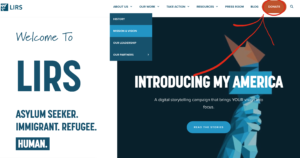
The secondary audience could be considered to be religious people (specifically Lutheran) and most likely people who are wealthy (aka wealthy Lutherans). When trying to reach the secondary audience, a non-profit should make it easily accessible to learn more about the organization. This website accomplishes reaching their primary audiences and their secondary audiences well by making the landing page include a donate option as well as the “INTRODUCING MY AMERICA” where I can easily learn more about the recipients of LIRS. 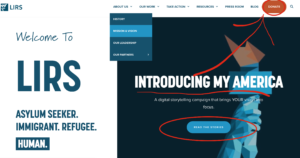 If I learn more, I’m more likely to donate. This also supports the values that the audiences might have. If I was a donor, I would like to know my money is going to actually help and support the mission. By clicking “read more stories,” I now have access to read about people who have actually received the service of LIRS.
If I learn more, I’m more likely to donate. This also supports the values that the audiences might have. If I was a donor, I would like to know my money is going to actually help and support the mission. By clicking “read more stories,” I now have access to read about people who have actually received the service of LIRS.
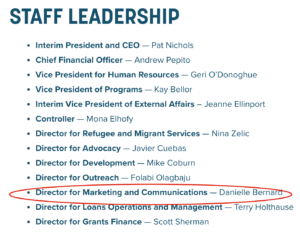
But who is behind lirs.org? Considering the author, it can be quite clear or we will have to make an informed guess (Arola, Sheppard, Ball 25). First, the non-profit organization should make their mission and who they are clear. LIRS makes this very specific and understandable after clicking “about us” and “mission & vision.” However, after clicking the “about us” and “our leadership” you can see the Marketing and Communications is Danielle Bernard:
I couldn’t specifically find out whether or not Danielle Bernard is a credible source. But maybe in the case of LIRS it doesn’t matter. LIRS website’s accomplishes reaching their primary and secondary audiences well. The author can also be interpreted as being the people that have been supported by LIRS through reading stories here on My America:
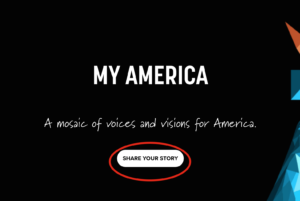
The genre of this website is geared as a non-profit organization. According to Wikipedia, the key aspects the audience expects from a non-profit organization are “accountability, trustworthiness, honesty, and openness to every person who has invested time, money, and faith into the organization” (Wikipedia, Nonprofit Organization). Just like we expect certain things from a horror movie or a newspaper, we expect a non-profit organization’s website to be accountable, trustworthy, honest, and open. I believe that is why LIRS almost always uses the color blue, which can signify trust, honesty, and faith.
The website accomplishes this also with the stories that are shared by those helped by LIRS:
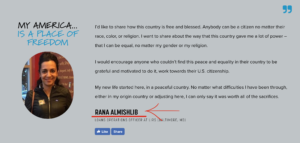
Here you can see that Rana Almishlib is a real person. This demonstrates LIRS as being honest and accountable. This one story is an example of many LIRS has shared.
Now, we must consider the context. We must think about the where, how, and what (Arola, Sheppard, Ball 24) of the website. The what is a website and how is using the Web to access it. When I searched in google “immigration and services,” lirs.org was the second option: 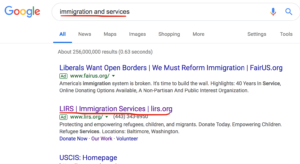
This can be seen as where many people can gain access to this website.
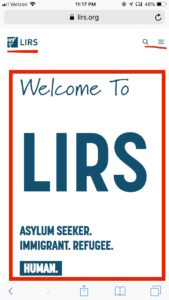
Also, on my iPhone, I found that the landing page is evenly spaced and organized. However, the “DONATE” button is removed. This shows how the context is different on our mobile devices and not as blatantly geared towards donors. Overall the website is easily accessible.
With all this in mind, what can we say is the purpose of this website? Writer/Designer explains that purpose can have a wide range of possible intentions (Arola, Sheppard, Ball 23). We must consider the primary purpose as well as the secondary purpose. The primary purpose is to gain support for the website, as we have already seen by LIRS targeting donors and supporters as their primary audience. However, the secondary purpose may be to demonstrate LIRS credibility. I saw it here, through them telling me simply how long they have been around, how many volunteers there are, how many partners, and how many immigrants they have welcomed: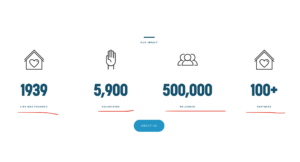
I found LIRS’s website to be what you should expect from a well designed non-profit organization’s website. The purpose and audience are well established through the website’s use of placement of buttons and usage of colors. Like anyone and everything, there are always ways it can improve. For LIRS, the website could have more stories from the people supported by LIRS to make my trust in them more well-rounded. I also will say that on the landing page, LIRS could add in a GIF/video to immediately get my attention. This GIF/video should be designed to touch the emotions of the primary and secondary audiences. However, with that being said, by analyzing LIRS one can understand what makes a excellent and well-thought out non-profit website.
Arola, Sheppard, & Ball. Writer/Designer: A Guide to Making Multimodal Projects. Boston, Bedford/St. Martin’s, 2014.
Wikipedia contributors. “Nonprofit organization.” Wikipedia, The Free Encyclopedia. Wikipedia, The Free Encyclopedia, 2 Feb. 2019. Web. 7 Feb. 2019.